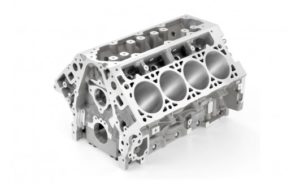Engine

Introduction
The burning heart of our fast cars, yeah you are right, I am talking about engine. It’s the power unit we have to spin our car wheels. The entire thrill we have got while driving depends on the capacity of this power unit, and the limits up-to which we can push its components to operate safely. It is the combination of all parts of an engine that makes a car to move faster and faster.
So let’s just dig out what it’s components are, and how precisely they must be engineered to get the maximum power out of an engine.
Main Parts of an Engine
1. Engine Block

Engine block is an important parts of an engine. It is made by pouring the molten iron or aluminum alloy into a mold. The mold is made such that we should have required number of holes in the casted block, which are said to be the number of cylinders of an engine or engine cylinders. The diameter of these holes is called the bore of an engine.
We have some more holes along the length of engine cylinder, these are water and oil flow paths required for cooling and lubrication of an engine. Oil paths or vents are rather narrower than water flow vents.
What else we have in an engine block is semi-circular seats. On these seats half part of thrust bearings (thrust bearings come in two parts) are mounted, then we place crankshaft in these thrust bearings. But we still need to hold crankshaft to the engine block, to do that we have bearing-caps.
Bearing-caps have a semi-circular seat for other half part of thrust bearing. To mount the bearing-cap with engine block we use studs and nuts. One threaded end of stud goes into internal threaded hole in engine block, and other threaded end of stud goes into hole in bearing-cap and we fasten them together with nut. Two studs are used for holding one bearing-cap in place.
Now that we know that why we have semi-circular seats, in an engine block, let’s take a look what we going to do with cylindrical holes in the block.
Comments
Post a Comment